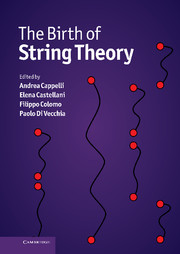Book contents
- Frontmatter
- Contents
- List of contributors
- Photographs of contributors
- Preface
- Abbreviations and acronyms
- Part I Overview
- EARLY STRING THEORY
- Part II The prehistory: the analytic S-matrix
- Part III The Dual Resonance Model
- 10 Introduction to Part III
- 11 From the S-matrix to string theory
- 12 Reminiscence on the birth of string theory
- 13 Personal recollections
- 15 Early string theory at Fermilab and Rutgers
- 15 Dual amplitudes in higher dimensions: a personal view
- 16 Personal recollections on dual models
- 17 Remembering the ‘supergroup’ collaboration
- 18 The ‘3-Reggeon vertex’
- Part IV The string
- TOWARDS MODERN STRING THEORY
- Part V Beyond the bosonic string
- Part VI The superstring
- Part VII Preparing the string renaissance
- Appendix A Theoretical tools of the Sixties
- Appendix B The Veneziano amplitude
- Appendix C From the string action to the Dual Resonance Model
- Appendix D World-sheet and target-space supersymmetry
- Appendix E The field theory limit
- Index
17 - Remembering the ‘supergroup’ collaboration
from Part III - The Dual Resonance Model
Published online by Cambridge University Press: 05 May 2012
- Frontmatter
- Contents
- List of contributors
- Photographs of contributors
- Preface
- Abbreviations and acronyms
- Part I Overview
- EARLY STRING THEORY
- Part II The prehistory: the analytic S-matrix
- Part III The Dual Resonance Model
- 10 Introduction to Part III
- 11 From the S-matrix to string theory
- 12 Reminiscence on the birth of string theory
- 13 Personal recollections
- 15 Early string theory at Fermilab and Rutgers
- 15 Dual amplitudes in higher dimensions: a personal view
- 16 Personal recollections on dual models
- 17 Remembering the ‘supergroup’ collaboration
- 18 The ‘3-Reggeon vertex’
- Part IV The string
- TOWARDS MODERN STRING THEORY
- Part V Beyond the bosonic string
- Part VI The superstring
- Part VII Preparing the string renaissance
- Appendix A Theoretical tools of the Sixties
- Appendix B The Veneziano amplitude
- Appendix C From the string action to the Dual Resonance Model
- Appendix D World-sheet and target-space supersymmetry
- Appendix E The field theory limit
- Index
Summary
The birth of string theory took place in the years from 1968 (Veneziano formula) to 1973–1974. At the time I was a young physicist interested in the dynamics of strongly interacting particles. This problem was clearly far from being solved but, due to the everyday increase of ‘elementary particles’ and their ‘strong’ interaction, one thing seemed sure to me: the answer was not to be found in quantum field theory!
From the Goldberger–Treiman relation, mNgA = fπGπNN, one obtained GπNN ∼ 10 for the pion–nucleon coupling constant. So a perturbative expansion for the strong interaction was clearly out of the question. But for me it was more than that.With all its ‘infinities’ popping up everywhere, quantum field theory (QFT) appeared to me not only inadequate but just conceptually ‘wrong’ on the whole, because of the large number of ‘unobservable’ quantities it introduced.
In the spirit of Heisenberg the description of the physical world was to be based only on ‘observables’! Since the only really ‘measurable’ quantities were the cross-sections in scattering processes, Chew's ‘bootstrap’ programme seemed the right conceptual framework and his book S-Matrix Theory of Strong Interactions [Che62] was (not only for me, I believe) the reference text.
Of course the calculation of the full S-matrix appeared too ambitious and the immediate objective was to obtain relations among a set of measurable parameters. In this context, a relevant method to obtain physical information was based on the idea, emphasized especially by Sergio Fubini and others, to use dispersion relations together with current algebra to obtain sum rules involving cross-sections.
- Type
- Chapter
- Information
- The Birth of String Theory , pp. 208 - 213Publisher: Cambridge University PressPrint publication year: 2012



